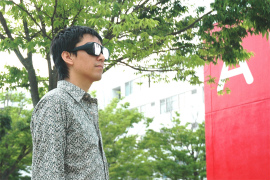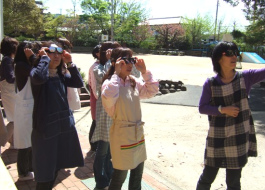Prof. Nakauchi, Department of Computer Science and Engineering received an Award from Ministry of Economy, Trade and Industry
28 Sep 2011
 Prof. Nakauchi won the award for his work on the "Development of a filter to simulate colorblindness for use in Color Universal Design (CUD)" from the Ministry of Economy, Trade and Industry.
Prof. Nakauchi won the award for his work on the "Development of a filter to simulate colorblindness for use in Color Universal Design (CUD)" from the Ministry of Economy, Trade and Industry.This Award is given to individuals for successful achievement or for leading efforts in collaboration activities between universities, public research institutes and business entities, resulting in significant contributions to the improvement and further development of these activities. The Award was inaugurated in 2003, and it has now reached its 9th year.
The Awarding Ceremony will be held on September 22nd at the Tokyo International Forum (Chiyoda-word, Tokyo) as one of programs in the "10th Promotional Convention for the Industry-Academia-Government Collaboration".
Reasons for Award
Prof. Nakauchi of the Toyohashi University of Technology, in cooperation with Prof. Shinomori of the Kochi University of Engineering and the Ito Koki Corporation, designed and produced an optical spectrum filter that can reproduce the characteristics of colorblindness in order for people who do not suffer from this condition to understand and to experience the effects of color confusion. The world's first commercialized filter comes in the form of both eyeglasses and of glass loupes as a CUD tool to remove barriers whereby those who are not color-blind have difficulty in understanding the condition, which works against the promotion and dissemination of CUD. Using the developed filter, color-blindness can be simulated easily and highly realistically. This filter is widely used by industries and in public facilities to check for problematic color combinations in printed matter, text books, public signs and displays for transportation facilities. Thus, it is highly evaluated in terms of its social contribution
 Outline of the achievement
Outline of the achievementFive percent of Japanese men are color-blind (color vision deficiency) and have difficulty in distinguishing specific color combinations. In order that those who are color-blind and those with complete color vision do not confuse colors, there is an urgent need for the implementation of CUD (color universal design). However, in general, those who are not color-blind do not have an intuitive understanding of the difficulties posed by colorblindness, and this presents a barrier to familiarizing and promoting the CUD concept. In this world's first development, a filter that modifies the optical spectrum to reproduce 'color-blind' characteristics was developed for commercial use in 2007.
Using this filter, which comes in the form of both eyeglasses and of glass loupes, the non-colorblind can experience the perceptual color confusion which in those who are colorblind is due to the lack of one type of cone cell out of the three that support color vision. Through the experience of simulated but highly realistic color blindness, it is possible to find problematic color schemes in almost any situation using the filter as a CUD tool.
Currently, the filter is being widely used for color combination tests in industry and in public facilities for printing material, public signs, and textbooks, including those used at CUD enlightenment seminars. For example, some railway companies revised the color combinations used in their time-tables and in railway network maps using this filter (Hankyu Dentesu renewed the design on the occasion of revision of their train time-table in March 2011.) Furthermore, the use of the filter has been increasing at organizations that produce public brochures and printed matter for general distribution. (In the Mie Prefecture, a total of 24 offices, including all of Departments in the Prefectural Office and the Prefectural Centers have introduced the filter). In addition, an overseas organization (the Natural History Museum in Finland (Helsinki)) has used the filter for testing their display signs.
 Professor Nakauchi's achievement has made a significant contribution to the familiarization and promotion of CUD by enabling nearly everyone to experience the diversity of color vision, and to realize problematic color combinations.
Professor Nakauchi's achievement has made a significant contribution to the familiarization and promotion of CUD by enabling nearly everyone to experience the diversity of color vision, and to realize problematic color combinations.Professor Nakauchi had previously been awarded the 2011 Award for Science and Technology (Development Category) from the Ministry of Education, Culture, Sports, Science and Technology for his achievement.



